Bill Hillman Presents
F.L.A.S.H.
Forces: Land ~ Air ~ Sea
~ Home
A MILITARY TRIBUTE WEBZINE
. . . AS YOU WERE . . .
www.hillmanweb.com/flash
Compiled by Bill Hillman
FLASH.
. . Editor and Webmaster: Bill Hillman: hillmans@wcgwave.ca

www.hillmanweb.com/rcaf/mag
October 2002
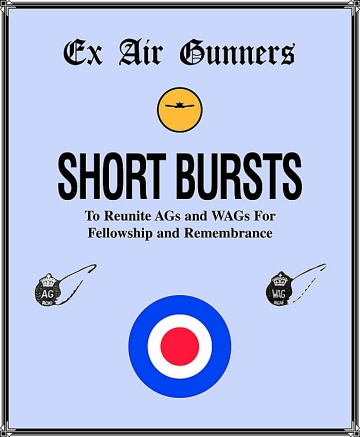
A Fu-Go Fire Balloon
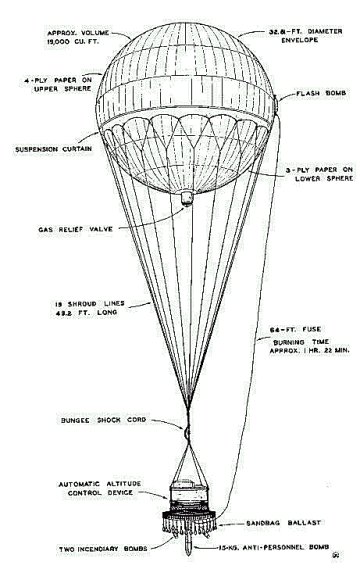
If one was to suggest to a resident in Western
Canada that enemy bombs were dropped on their Provinces during World War
Two, they would look at you as though you had lost your marbles, start
measuring you for a straight jacket, or at least, dial 911! But it
is a fact.
The “Fu-Go-Weapon” project initiated in 1933 to design
a constant altitude balloon capable of carrying explosives over enemy positions,
was re-established by the Japanese. A new prototype was developed, ingeniously
designed to be launched from Japan carrying an average pay load of 50 pounds
of bombs, 3 incendiary and one anti-personnel. The balloon envelope was
constructed of laminated layers of paper made from the mulberry tree. Finished
panels were protected with a coat of lacquer and, as production demands
increased, the panels were sent out to subcontractors for final assembly.
The dexterity and sharp eyes of thousands of Japanese school children were
involved in this part of the process.
By November 1944 the first ten thousand balloons were
ready. With the release of the first balloon on November 3rd the Japanese
air assault against Continental North America had begun. The balloons were
designed to be carried by the jet stream from their launch point in Japan;
a river of air travelling at speeds approaching 200 miles per hour, at
altitudes of 30,000 to 38,000 feet. This airborne weapon was meant to start
fires in our forests and cities and to create panic among the peoples of
Canada and United States.
The American and Canadian Governments concluded the
best defence against panic was to say nothing of the new menace and play
down local anxieties. In this way Japan would be deprived of any knowledge
of whether or not the new weapon had been successful – a weapon which was,
in effect, the very first Intercontinental Ballistic Missile (ICBM).
On Feb. 21, 1945, P/O E.E. Maxwell, 133(f) Sqdrn.
Pat Bay, British Columbia, was scrambled in an RCAF Kitty Hawk 1V and took
off to investigate a balloon sighting. He intercepted a Japanese fire balloon
over Sumas Prairie and shot it down in a ball of flames. On March 10, 1945,
P/O J.G. Patten, flying Kitty Hawk 858, intercepted a balloon at 13,500
feet near Patricia Bay, B.C. Patten shot the balloon down and no damage
resulted. On March 12, 1945, F/L R.L. Moodie and his crew from 6BR Squadron
Coal Harbour, were completing the last leg of their daily patrol in Canso
9702 when they sighted a partially deflated balloon drifting eastward at
about 500 feet. By flying above the balloon, Moodie was able to force it
down. This balloon was recovered by a search party from #120 (BR) Squadron.
Wireless Operator Ray E. Woolston of Calgary Alberta was active in the
recovery and the balloon, which was neutralized, was shipped to the National
Research Council in Ottawa.
On May 5, 1945, an encounter with a fire balloon
claimed the lives of six Americans. The Reverend Archie Mitchell and his
wife took five children on an outing to a picnic area about two hours drive
north east of Klamath Falls, Oregon. Reverend Mitchell was still in the
car when his wife called out that the children had found something strange
tangled in the trees. The Reverend shouted a warning but it was too late;
one of
the bombs exploded killing Elsie and the children. Weapons constructed
by children - killing children. The deaths occurred one month after the
Japanese had discontinued the Fu-Go program.
From November 3rd, 1944, to early April 1945,
the Japanese launched 9,300 balloons. Only 285 were accounted for
in reports turned in to American and Canadian authorities. The last
recorded discovery was made in 1955 by a bush pilot flying along the Yukon
River. One balloon bomb was found at Stony Rapids in Saskatchewan.
How many of these un-detonated weapons are still hanging
from trees in the mountains of British Columbia or buried in the bush and
muskeg of Alberta, Saskatchewan, and Ontario?
If anyone has further information on the Fu-Go
balloons, please contact Editor John Moyles.
(Ed. The above information was gleaned from
the book JERICO BEACH and the west Coast Flying Boat Stations by
Chris Weicht
ISBN 0-9681158-0-2)
In the August Short Bursts Page (see Archives
at bottom and click on August 2002) there was an article on P/O Cox (then
F/S) and crew, and the loss of Stranraer #951. FRED BURNYEAT has
provided us with this follow-up article.
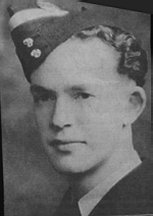
P/O Everard Cox in training
The Vancouver Sun, Saturday Aug. 17, 2002.
By Jim Beatty (In part)
VICTORIA – Sixty years after the death of her
father she never knew, Lynneve Stewart is planning the funeral he never
had. Fearing her heroic father would be lost in a black hole of war history,
Mrs. Stewart and a small group of relatives and military officials are
preparing to honour eight Canadian service men who died off the West coast
of Vancouver Island, August 23, 1942.
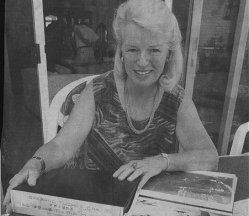
Lynneve Stewart with mementoes of her father, Pilot
Officer E. Cox
Poignantly, Lynneve was born four days after
her father’s plane went down.
“People shouldn’t just disappear into oblivion
when a file is closed,” said Lynneve, “this is a time we can acknowledge
the lives of these men and the contribution they made to Canada … Hopefully,
it will give my children a sense of the Grandfather they never knew.”
(Ed – Go to Archives, August 2002, for the
full story.)
As this Page was going to press Lynneve Stewart
was kind enough to make available pictures of the Memorial ceremony held
on August 24, 2002.
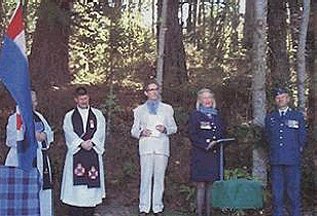
Lynneve Stewart and Dr. Van Allen
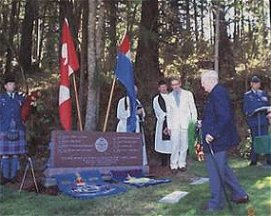
John Beeching,
brother of Sgt. C.F. Beeching laying wreath
|
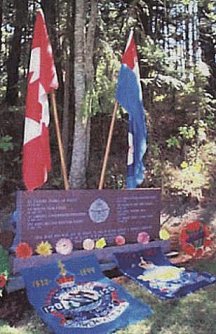
Memorial in
Commonwealth War Graves Section,
Victoria’s Royal Oak Burial Park
Victoria, British Columbia.
|
The Memorial lists the eight men and reads
“These brave men were lost in action and
attacked by a Japanese submarine on August 23, 1942.”
Crew - Stranraer #951
F/Sgt Everard T. Cox – Pilot -
F/Sgt LawrenceA.B Horn – 2nd. Pilot – Regina, Sask.
Sgt. Robert B. Stuart – Navigator – Vancouver, B.C.
F/Sgt. Mervyn Cram – WAG – Renfrew. Ont.
Sgt. A.W. Anderson – WAG – Selkirk, Man.
Sgt. K.E. Hope – AFM – Vancouver, B.C.
Sgt Leslie Oldford AEM – Penhold, Alta.
Sgt. C.F. Beeching AEM – Regina, Sask.
FROM BERLIN TO SWEDEN
– OR –
CANADIANS PLAY HOCKEY
IN SWEDEN 1943.
By Jim Flick
Halifax MK 11, LQ.V, 405 Squadron . Grenadine Lodge,
England, August 23, 1943.
Crew:
WO1 Smith - Pilot
F/O Davies - Navigator
Sgt. Cassion – Bomb Aimer
Sgt. O’toole - Wireless Air Gunner
Sgt. Catlin – Flight Engineer
Sgt. Gate – Mid Upper Gunner
Sgt. Jim Flick – Rear Gunner
|
We had been on two long trips, first Nuremburg
on the 10th of August and Turpin on the 12th August. After the Turpin
trip our pilot F/S Robinson became ill and we were given another pilot,
WO 1 Hector “Snuffy” Smith, RCAF. We carried out several training flights
and a couple of dry land dinghy drills insisted on by our Navigator, F/O
Davies.
During our training period we missed 5 operational
trips up to the 22nd of August and, now that we were considered operational
again, we expected to get the next one. I shall never forget that briefing
when the curtain was removed revealing the tape running all the way to
Berlin, the big one! I guess a little shudder of fear ran through me, if
not everyone present. We took off at 22:00 hours, crossed the Dutch coast,
and then it was almost straight ahead for Berlin. Target Indicators (T.
I,s) were to be dropped over Berlin at 17 minutes before midnight.
According to the Navigator, at this predetermined
time, we were over the centre of the city. At that moment I reported that
T.I.s were going down approximately 5 miles behind. We were then coned
by searchlights. The pilot pulled the aircraft around and up and then straight
down into the centre of the cone. In that first violent maneuver I blacked
out in my rear turret. When I came to a few seconds later I was looking
at the nose of a Messerschmidt 109, his wing gun fire going by me on both
sides taking most of our fins and rudders. He was sitting out there about
100 yards away, a point blank shot for me, so I fired. At the same time
the Mid Upper Gunner was taking care of another ME 109 as it came down
across the rear turret with guns blazing. At the same time my ME 109 fired
his cannon and the burst came in through the glass blister of my turret
leaving a piece of shrapnel in my shoulder.
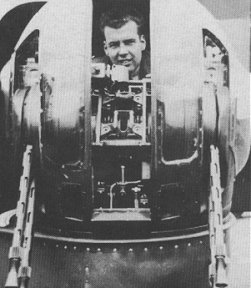
Sgt. Jim Flick in his Rear Turret
By this time we were at 5,000 feet directly over Berlin.
The pilot pulled out of the dive and headed North-North West. We did not
see any more fighters that night. Our electronics were shot out and we
still had our I.T.s on board. The Flight Engineer checked our fuel and
we and we did not have enough to return to England. The aircraft was trying
to stall so we got rid of the bomb bay T.I.s by manually dropping them
through the floor. We still had four bombs on the wings, two on each side.
The aircraft finally levelled out. It was those wonderful Merlin engines
that got us out of that scrape. The pilot must have firewalled them all
the way to the Baltic Sea.
We flew near the coast of Sweden and drew some
anti-aircraft fire from the Swedish gunners, but it was nowhere near us,
just part of their neutrality act to fire on any aircraft entering their
area. The pilot decided to ditch the tired old “V” for Victor about three
miles from the Swedish coast near Ystad. It was 3:00 hours, August 24,
1943. Our dry land dinghy drills certainly paid off as everyone knew exactly
what to do. According to our Navigator we cut our dry land time in half.
We floated for about six and one half hours before
being picked up by the Swedish Coast Guard and taken to Ystad. We were
met by a Swedish Airforce Officer by the name of Lieut. Yackobie. We had
been told about him in our briefings at Squadron. He was reported
to be pro-Nazi. He was very friendly, gave us cigarettes and beer, but
we did not tell him anything.
After taking myself and the bomb aimer to the
hospital we were put on a train and taken to Falum, about 160 miles from
Stockholm, to Internment Camp #4. We remained at that camp for a number
of weeks and, as more airmen were arriving, the camp became too small.
We were sent to ski lodges in the country. They were luxury hotels!
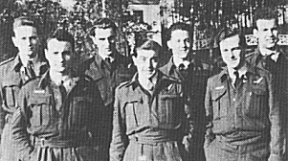
Crew of Halifax LQ-V.
Front – O’tool, Gatling, Davies
Back – Gates, Cassidy, Smith, Flick.
We were given civilian cloths, skis, skates,
etc. A reporter from Stockholm saw a few of us playing hockey on the lake
near the lodge. He asked if we were Canadians and if we would make up a
team to play a Swedish team. He arranged and paid for all our permits,
travel expenses, and we played 24 games. It was a great way to fight a
war.
We were repatriated to England on March 16, 1944
and given 5 weeks leave. It was back on operations again on May 27, 1944,
with 432 Squadron. We completed one tour (35 Ops) in October and returned
to Canada in November 1944.
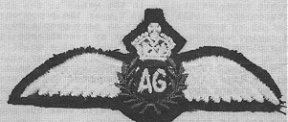
Air Gunner wing issued Sgt. Flick on graduation
From #9 B&G Mont Joli.
This style of wing was later withdrawn.
Submitted by Member
Don Daikens – Short Bursts #42, 1993
As Charles Dickens so succinctly put it:
-“It was the best of times; it was the worst of times.”
We were near the end of our tour of operations. We
had survived everything Mother Nature and the enemy could throw at us.
Icing at 20,000 feet with full bomb load; flying through thunderheads and,
with full bomb load, watching St. Almos’ fire dancing along the aerial;
a Pilot that could not even spell the word “Abort”; hitting the target
with only three engines operating; being coned from the target area to
the coast; attacks by night fighters; being used as target practice by
the mighty 88’s; fire on board; Lancaster bombs from above going through
our wings; oxygen system in my turret knocked out and operating on emergency
bottles; bringing a flying junk heap back to Carnaby where it collapsed
totally in front of the hangar, and all the other little exciting things,
like being blasted by our own guns as we flew through the IAZ area of the
Supreme Allied Headquarters.
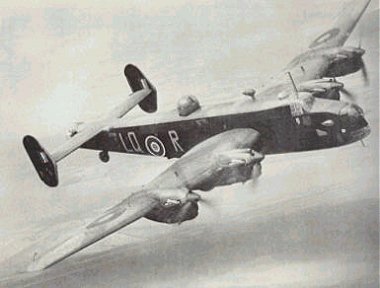
Halifax B Mk 11 - Merlin Powered
View of Mid Upper
This was it! We had started our tour of Ops
on Squadron 76 RAF on the 21st. day of August 1944, and had been on both
day and night raids. We were now returning from our 30th. trip which had
been to Hanover, Germany. The trip had been uneventful and for once our
aircraft ‘R’ for Roger, was totally intact – nary a scratch on it. I was
sitting in my Mid-Upper position and as we got closer and closer to England,
the adrenalin was flowing faster and faster. WE WERE GOING TO MAKE IT!
WE WERE GOING TO LIVE! We had completed the magic number of 30 Ops. Talk
about Luck!
Each member of the crew had a new, almost kid like,
sound to their voice. Yessssir! We were a-going Roaming in the Gloaming
– do Knees Up Mother Brown, and spend the last tuppence on a mug of bitters.
Talk about happy, when we finally came to rest
at the dispersal point we jumped out of our old Hally, kissed it and started
punching each other like a bunch of kids. We had made it … safe and sound!
So much for the enemy, we were INVINCIBLE! Soon the lorry came around to
pick us up to take us back to the flights for de-briefing and we kidded
the WAAF driver all the way. We were going back to Canada … come on over
and visit us sometime.
In the de-briefing room the feeling of exhilaration
grew stronger and stronger. Finally a table emptied and we went to tell
our stories for the last time to our favourite Flight Louie. After each
of us had reported on what we had seen and done, the hammer fell … Our
favourite Flight Louie looked at us with a sad look on his face and said,
“ I hate having to be the one to tell you chaps this, but … Bomber Command,
in all it’s wisdom has decreed that, since the front lines have been pushed
back almost to the German boarder, the number of points required to finish
your tour has been altered. You Gentlemen have NINE more trips to do before
you are screened.”
Each member of our crew were incredulous. Sheer
shock was stamped on every face. This was unheard of! It had never happened
before. I was sick to my stomach. Nine more trips. We will never make it.
The fighter threat had receded but the flak was picking up in intensity
and accuracy as all the enemy units were being compressed into smaller
areas. The last nine trips were deep into Germany, some bombing in support
of the Russian troops on the Eastern front and the rest in Happy Valley;
each one at night and all bloody tough targets.
We all lived through it but it took over a month
to complete those nine trips during January and February 1945. When
we finally did finish we contained our emotions until we were told, officially,
that we had been screened. I had turned 19 in September 1944 and, during
those last nine trips, I stared to notice a small piercing pain in my right
abdomen. It appeared and disappeared so I took little notice of it.
In August 1945, back in Canada, I was admitted
for the removal of my appendix and a month later started treatment for
duodenal ulcers. The enemy had finally won! I spent ten years on medication
to ease the pain they had given me.
As Charles said, “It was the best of times; it
was the worst of times.”
Branch
Reports
There was just one report this month. ‘Smokey’ Robson,
President of the Northern Saskatchewan Group, reported that they had 20
turn out to their steak dinner in September and their monthly luncheons
are well attended.
CORRESPONDENCE
From Ted and Gene Hackett
A memorial cairn stands today 8 miles west of Cochrane,
Alberta, on the old Banff highway now known as highway 1A. On the cairn
are two brass plaques, the one on the East side (left in photo) commemorates
the co-operation between the USA and Canada during the war. The other
plaque lists the names of two airmen who were killed in the crash of Cessna
Crane W1610 on February 17, 1941, in the valley near that location.
The two airmen were R56882 Sergeant Alfred Emile Regimbal from Wood Mountain,
Saskatchewan, a pilot age 22. The other airman was R67694 LAC Quenton
Burl Chace from Wichita, Kansas, USA, age 20. Both airmen were from
No.3 SFTS, Calgary, Alberta. LAC Chace was killed just before he
graduated. The cairn seems to be well looked after, the grass has
been cut and the whole area was neat and tidy when we stopped to photograph
it. A sign at the side of the highway lists it as a "point of interest".
These two airmen were strangers to me but I felt
a kinship with them and the quotation from Henry V came to mind. We few,
we happy few, we band of brothers. We were a band of brothers were
we not?
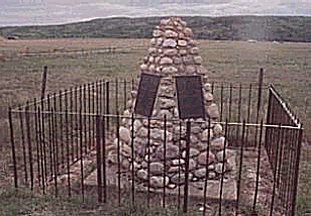
OXFORD
DEDICATION
The Vintage Aircraft Restorers will have a
ceremony of dedication and handover to the Western Development Museum of
the Funk Sport Plane/Airspeed Oxford and Tiger Moth aircraft. This will
be held 14 November 2002 at 7:30 pm in the museum at Moose Jaw. All members
of No. 600 Wing are invited to attend. Former pilot of Oxford #24,
Jack Ambler, will be on hand to do the unveiling.
Weldy Moffatt
John:
A book that I am sure you would enjoy is "The Bomber
War" by Robin Neillands published by The Overlook Press in 2001. It tells
the Europe Bomber War of The RAF and USAAF in a different Historical manner
than any I have previously read. It has the best info on Dresden and what
really happened there and should be read by all the critics of Harris and
his crews. Neillands is a Historian.
Glen Clearwater
Letter from Allan Coggon, Editor of Nova Scotia Air
Crew association Newsletter “TAILWIND” advises that the Air crew Statue
(which was originally to be located at Pier 21) will be unveiled by the
Governor General October 20th. 2002, at Greenwood, Nova Scotia. The Statue,
to be placed outside in the Memorial Garden, will be illuminated at night.
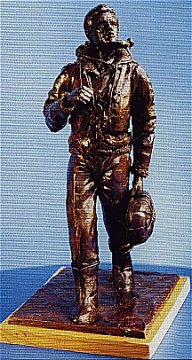 |
THE AIRCREW MEMORIAL ASSOCIATION
Left -12” replica of life sized statue to be
unveiled
Oct. 20th. 2002, in memory of those who didn’t return. |
A plaque was unveiled at pier 21 to honour
RCAF Personnel who passed through this historic port during WW11.
Editor’s Report
When the chaps at the CATP Museum offered to host
and cover costs of our Short Bursts Web Page it was suggested that we use
it to re-publish articles that had appeared in Short Bursts from 1983 to
September 2000. So far we have been able to add new material submitted
by Members and use old Short Bursts articles to fill the page. It is hoped
that Members will continue to send in articles for this Newsletter. There
are a million stories out there. Let’s hear from you.
I understand that some members on the internet
are making copies of each month’s Page and taking them to the monthly meetings
of their Ex-Air Gunner’s group. This is great. I would like to suggest
that Members could pay a reasonable fee for this service and the proceeds
sent to the CATP Museum in Brandon (address on this page) to help them
defray internet costs.
Please drop Doreene and myself a line with suggestions
on how we can make this Short Burst’s page more interesting.
Until November, Keep well.
Cheers, Doreene and John.
Please note that Doreene and I have a new address:
John and Doreene Moyles,
Ste. 233 - 1060 Dorothy St.,
Regina, Sask. S4X 3C5 CANADA
Ph. (306) 949-6112
|
Regional Meetings
Southern Ontario Chapter
Royal Canadian Legion
Wilson Branch 527
948 Sheppard Avenue West
Downsview,Ontario
We meet the first Wednesday of each month at the Legion hall 1:00
pm.
No meetings July, August, September.
Contact persons:
Ken Hill ~ President ~ 905.789.1912
Bill Cockburn ~ Secretary ~ 416.492.1024
Email: piperbill@home.com
Winnipeg
Location - Royal Canadian Legion Br.#4 St. James Legion.
Date - Second Thursday of each month.
Time - Luncheon meeting (provide your own lunch).
Contact Member - Charlie Yule Ph. (204) 254-6264.
Northern Saskatchewan
Location - Lynx Wing Ave. C North, Saskatoon.
Date - Third Monday of the month.
Time - Luncheon meetings.
Contact Member - C.A. "Smokey" Robson Ph. (306) 374-0547.
Northern Alberta Branch
Location - Norwood Branch 178, 11150 – 82 Street, Edmonton, AB
Date - Third Tuesday of each month.
Time - 12:00 hours.
Contact Members - E. H. "Ted" Hackett (780)962-2904
or Sven Jensen (780)465-7344.
Southern Alberta
Location - Royal Canadian Legion #264
Kensington, Calgary
Date: Second Monday of each month.
Time - 11:30 hours.
Contact Member: Dave Biggs Ph: (403)236-7895
or Doug Penny Ph: (403)242-7048.
Note:
October meeting time moved to third Monday.
Also there are no meetings in July and August, however, a Barbecue
is usually held at Larry Robinson's ranch in Okatoks during that
time.
British Columbia Branch
Meeting time and local: 2nd Tuesday of each month at 12 noon,
Canadian Legion, 4896 Delta, Ladner, B.C. (no eating facilities)
Contact person - Dave Sutherland
Ph. (604) 431-0085
E-mail distilledwater@home.co
Members across the Country are encouraged
to
send current information regarding
regular meeting places, dates, and Contact
Members, to
John and Doreene Moyles,
Ste. 233 - 1060 Dorothy St.,
Regina, Sask. S4X 3C5 CANADA
Ph. (306) 949-6112
Members are requested to send their experiences, articles, anecdotes,
pictures, etc., to John Moyles and I will forward them to our Web Master
in Brandon. Articles and Last Post items will be deleted from the page
each month after the designated Member in each region has had an opportunity
to copy the material for their Members. Notices of deceased Members are
to be sent to Charlie Yule who is still our 'Keeper of the Rolls'. This
is your SHORT BURSTS with no printing or mailing costs, and no deadlines!
We thank our Web Master, Bill
Hillman, for his volunteer time and expertise. |




Webmaster:
William G. Hillman
BILL
& SUE-ON HILLMAN ECLECTIC STUDIO
Editor and Webmaster Bill Hillman
~ Copyright 1996-2021
©
2008 Bill Hillman and Ex-Air Gunners Association














